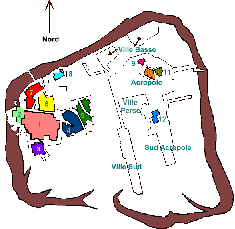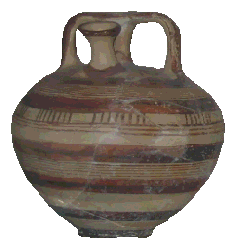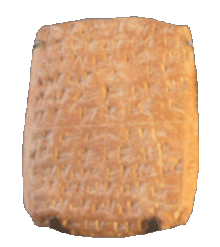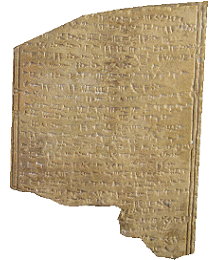Ugarit
Our website is dedicated to the Phoenician cities, which were recognized under this name from the late twelfth century BC, following the invasions of the Peoples of the Sea. Unfortunately, these assaults effaced some of the old great "Canaanite" cities (like Ugarit) from the ancient landscape forever.
The city of Ugarit already had well advanced maritime relations with the Aegean world, and exchanges were prospering on both sides. The richness of the city was at the same level as its neighbors, sometimes even more prominent. If we choose to present this city it is in order to evoke its precursory role in two major sectors: The maritime (with exchanges) and the cultural (the Ugaritic alphabet). Ugarit cannot be described as "Phoenician" but rather as "Canaanite". It can be considered as the "instigator" of the expansion and the activity motor of future Phoenician cities. A historian wrote, "Ugarit thus appears as a Thalassocracy, rival of Mycenaeans, and prefiguring the greats Phoenicians enterprises, especially those of Tyre and Sidon"(1).

The god El, by J. Achkar
© Pheniciens.com
Coastal city in present-day Syria, the city of Ugarit is now known under the name of Ras Shamra (cap fennel). The site is located 15 km north of the present city of Latakia, bordering the Mediterranean Sea. Archaeological excavations began in 1929 following a fortuitous discovery by a farmer plowing his field and striking a tomb filled with ceramics. At that time, Syria was under French mandate. The mandatary power, which had just created an Antiquities Service under the direction of René Dussaud, immediately sent to the site the archaeologist Claude Schaeffer, who devoted himself to the site exploration until his death in 1982.
Ugarit, the great northern Canaanite port, known previously only through the ancient archives of tell El-'Amarna (capital of Akhenaten) and destroyed by the invasion of the Sea Peoples in 1186 BC, was ready to reveal its secrets.

Site Map Ugarit
The site of Ugarit, is one of the oldest in the Ancient Near East, and was occupied since the Neolithic period (6500 BC). The copper industry had appeared in that city in the early fourth millennium. Around 3000 BC, an important city emerges, surrounded by fortifications. The beginning of the second millennium marks a turning point in the history of the city, with the arrival of the Amorites(2), a people of nomads and craftspeople specialized in casting bronze. Ugarit was the capital of a flourishing kingdom positioned at the intersection of land routes of the Near East, and the maritime routes of the Mediterranean. The city was located on a strategic axis of that time, its kings had to defend themselves against the powers all around. In the South: the Pharaohs of Egypt, and in the north (on the foothills of the Taurus), the kingdom of Mitanni(3) and later the Hittites, in the east: the Mesopotamian world and in the West, the Mediterranean (Aegean world).
That position at a crossroads of commercial and cultural exchanges at a north-south intersection (Hittite world - Egypt), and another east-west (Mesopotamian world - Mediterranean), enriched that kingdom through trade and the development of luxury crafts. Ugarit was situated at the emergence of a fertile plain, where were cultivated grapevine, wheat and olive trees, which encouraged exportation of wine and olive oil. Its port welcomed Egyptian and Cretan vessels which unloaded alabaster, copper and precious Mycenaean craters. The caravans arrived from the Inlands, and filled wealth of the distant lands. Archaeologists found, during various excavations, lapis lazuli from Afghanistan, ivory from India, amber from the Baltic...

Pottery Ugarit
The Royal Palace
Constructed behind walls, the royal palace was made from wood and adobe, extended over 10 000 m2, representing 5% of the city area. The unearthed foundations have determined the overall position: the entrance was through a monumental porch, facing west, supported by two columns. A paved courtyard gave access to a second courtyard leading to the throne room. All around, many small rooms were used to store the royal archives. Behind the throne room, there was a succession of courtyards, embellished with basins and canalizations which were still visible. Around the courtyards, a dozen small rooms with stairs leading to a higher floor, more airy, were reserved to the royal family.
In order to reach the Acropolis, which was to the east of the site, one had to cross the residential areas, group of houses delimited by narrow streets of two meters wide. The houses were organized around a central courtyard which opened onto small rooms in the ground floor, that served as sheds or workshops. The floor and the terrace were reserved for family life. Excavations have revealed the presence of a basement vault in many houses, where they buried the deceased family members(4).
The religion

Ugarit Baal
The scattered remains of the Temple of Baal make the global vision difficult. Archaeologists have supposed that the temple possessed a first courtyard enclosed by a wall in which was a first stone altar. Beyond this courtyard, was the sanctuary dedicated to the god of the city, Baal. Staircase vestiges suggest that the temple had a high floor, visible from the sea, on whose summit was lit great sacrificial fires.
The pantheon of Ugarit, as other pantheons of the Ancient Near East, brought together a multitude of deities. We find many similarities with the gods of other Canaanite cities of the Mediterranean coast.
Baal, the god of the storm and the fertilizing rain, is represented, brandishing his mace, the symbol of lightning, and gushing forth the foliages of the ground, thereby expressing the vegetation rebirth. He is often wearing, either an Egyptian gold crown, or a crown tiara like the Mesopotamians.
Yam, the god of the sea was opposed to Baal. Mot, the god of the harvest and of death, disappears underground when Baal was reborn. Also found there were: Dagan, the god of wheat and the plow. Aliyan Baal, god of the waters, wells and rivers, Anat, the regenerative sister of gods. And obviously Asherah or Astarte was also celebrated as the goddess of love and fecundity.
The Ugaritic alphabet
Archaeological excavations have revealed texts in eight languages and five writing systems that reflect the multicultural nature of this merchant Kingdom(5). But two writing systems and languages were the two most common:

Ugaritic alphabet
The Ugaritic, denoted by a local alphabetical writing appeared around the fourteenth or thirteenth century BC. This language was especially used to write testimonials of daily life, such as private documents, commercial contracts, family letters, ritual texts, omens(6), lists of divinities, etc.

Ugaritic alphabet
The Akkadian, an Assyrian and Babylonian language created in Mesopotamia. It became the international language in the second millennium BC, and was denoted by a syllabic-ideographic script. Administrative and official acts were prescribed in that language, as well as lists of personages and geographical lists. It mostly evoked the relationships of the kingdom with the political powers of that period.
Only Ugaritic was used to transcribe the local tradition myths. These myths attest to some conformity with the biblical stories, testifying the existence of a common cultural heritage, which is called "Canaanite" (see note 4).
The Ugaritic alphabetic writing system was among the first of simplified forms, reducing the number of signs, and allowing an easy apprenticeship, hence facilitating the freedom of expression. This innovation was completed in Byblos, three centuries later, by the abandonment of cuneiform and the adoption of the Phoenician script. The Phoenicians had the benefit of popularizing the alphabet, by adapting it on lighter media, such as papyrus and allowing the substitution of clay and stone tablets.
(Photos: Louvre Museum - Department of Near Eastern Antiquities: Levant - The Phoenicians Kingdoms)
| (1) |
Cf. Guy Rachet, Dictionnaire des civilisations de l'Orient Ancien, Editions Larousse-Bordas, 1999. |
Retour texte |
| (2) |
Population de langue sémitique qui apparaît à l'époque du Bronze Ancien. Leur nom akkadien amurru désigne l'Ouest et le vent qui souffle de ce point cardinal. Présents dans le monde syrien dès le III°millénaire, ce sont des nomades dont la région d'origine se situe vers le Moyen Euphrate dans le désert de l'Est de la Syrie. |
Retour texte |
| (3) |
Royaume constitué vers le XVI° av.J.C. sur le haut Khabur en milieu hourrite |
Retour texte |
| (4) |
Les Rephaïm sont des Mânes, les âmes des morts considérés comme des divinités, qui étaient dans la Syrie du II°millénaire l'objet d'un culte. Il y a dans ce culte l'écho d'un culte des héros qui sont en effet les ancêtres glorieux sur lesquels se fonde l'avenir d'un peuple mais avant tout la fécondité de la terre puisque les Rephaïm habitent une demeure souterraine. |
Retour texte |
| (5) |
Les collections de l'Histoire, n°22, janvier-mars 2004, l'Orient Ancien. |
Retour texte |
| (6) |
présages, pronostics. |
Retour texte |




